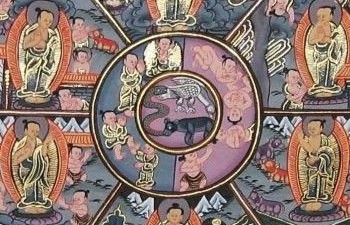STORY A: Bardo

Wikimedia Commons
There’s something about them Buddhists. They always have this demeanor that they know something that we don’t. The secrets to the universe, the answer to “what’s the sound of one hand clapping?” and why the j is silent in jalepeno. Another thing that they’ve introduced, or rather shared with the rest of us, is the concept of Bardo. They believe in life, death and reincarnation that follows, and also a space between death and afterlife that they called Bardo. It’s much like college where you have a little recess between lectures. But the kind where you experience a spectacular bright light. In that sense, it’s nothing like college. In fact, it can be experienced all throughout the life and death cycles. Specifically when one experiences heightened moments of enlightenment or liberation: Birth, Death, Afterlife, Dream and Meditation.
_embracing_his_consort_Vajra_Vetali,_in_the_corners_are_the_Red,_Green_White_and_Yellow_Yamari.jpg)
Wikimedia Commons
The Bardo of death comes, well, at the moment of death (no points for guessing that one). During this ‘transition’, the body encounters a bright light. B grade horror movies would have a group of people holding hands and telling the spirit to “go towards the light” at this moment. Apparently there’s truth to the cliché.
What follows next is the first Bardo of afterlife. The soul has a lot of work to do here. Firstly, it has a chance to encounter other spiritual beings. Their appearance is accompanied by clear, bright and sharp lights described as having an overwhelming brilliance. The second Bardo, visualized as a tunnel-like experience, requires for the soul to ‘wake-up’ as in a lucid dream, and begin a journey towards a more conscious state of awareness where it can evolve spiritually. The third and last stage of Bardo of the afterlife is the point of reincarnation. Here the soul’s karma leads it into its new womb.
STORY B: Near Death
Let’s put aside Buddhist’s beliefs for a moment and talk about modern day Near Death Experiences (NDE).

Wikimedia Commons
We’ve progressed far enough in terms of life-saving technologies to put the grim reaper out of business. As we’ve grabbed people back from the clutches of death, there have several accounts of NDEs which have been documented and studied systematically. The experience is usually accompanied by sensations of peace, body separation awareness, tunnel experience, beings of light, encountering the deceased, absolute dissolution, and immersion into light. Why are they having these ‘sensations’?
Wikimedia Commons
Now you know, most of the guys in the lab coats are bound to call them hallucinations. On the other hand, most guys with no lab coats like parapsychologists and religious believers point to them as evidence of an afterlife and mind-body dualism. There has also been a Dutch scientist who studied the phenomenon and states that continuity of consciousness may be achievable if the brain acted as a receiver of information generated by memories and consciousness. This also means that the information should exist independently from the brain. Much like a radio, TV or a computer can exist separately from the data received by them.
Biologists studying the phenomena have their own explanations to the ‘hallucinations’:
- A massive release of DMT (psychoactive stuff that the shamans used for divinatory and healing purposes) from the pineal gland prior to death or near-death. Injected DMT produces an experience where users enter non-corporeal, free-standing, independent realms of existence inhabited by beings of light.
- High levels of carbon dioxide in the blood, alters the chemical balance of the brain and tricks it into ‘seeing’ things. Mountain climbers who’ve experienced carbon dioxide spikes at high altitudes have reported seeing bright lights and having other hallucinations similar to NDEs.
- Depletion of oxygen supply to the eye resulting in the loss of peripheral vision, and leading to tunnel vision.
High neurophysiological activity during the near death state has also been found to exceed levels experienced during the conscious waking state, suggesting heightened signatures of consciousness at near-death. And these experiences seem to have a drastic change in the personality and outlook on life of the observer. Screw self-help books… almost dying is the way to go! Psychologists have identified a consistent set of value and belief changes with NDE subjects including a greater appreciation for life, higher self-esteem, greater compassion for others, a heightened sense of purpose and self-understanding, desire to learn, elevated spirituality, greater ecological sensitivity and planetary concern, and a feeling of being more intuitive.
Think About It
Now here comes the cool part. The Bardo Thodol outlining the experience was composed in the 8th century. The NDE studies have been documented only the last 5 decades. And they say the same things! Experiencing brilliant light, seeing other spiritual beings, tunnel experience amongst others.What do you think the truth is? Do other cultures have similar beliefs? Do the Mayan and the Egyptians perhaps have their own version? That’s something to think about.
Learn More
The Tibetan Book of the Dead: A Tour | Near-death experience in survivors of cardiac arrest: a prospective study in the Netherlands
About the Authors
Jaya Ramchandani works on several astronomy and physics outreach projects. She is also a co-founder of Sirius Interactive, a language solutions company for researchers.
Jonathan Dias freelances for magazines and papers like Maxim and the Herald, writing about women, food and gadgets. He is also attempting to write a cook book that involves a lot of bacon and beer.


